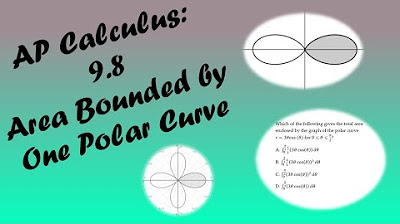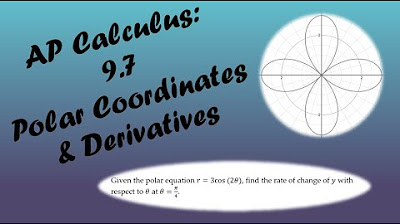Double Integration in Polar Coordinates | Example & Derivation
TLDRThis video script delves into the concept of polar coordinates, offering a refresher on their definition and advantages over Cartesian coordinates for certain applications. It illustrates how to derive the formula for integrating a function over a region in polar coordinates and applies this to compute the volume under a surface defined by a polar curve. The example demonstrates the process of approximating volume using small wedges and the double integral in polar coordinates, highlighting the significance of the 'r dr dθ' term. The video concludes with an integral calculation for a cardioid region, resulting in a final volume of 5π/3.
Takeaways
- 📚 The video discusses the process of computing the volume underneath a surface using polar coordinates, which are more suitable for certain regions than Cartesian coordinates.
- 📐 Polar coordinates are introduced as a coordinate system where points are defined by a radius r and an angle θ from the positive x-axis.
- 🔍 The conversion between Cartesian and polar coordinates is explained with the formulas x = r cos(θ) and y = r sin(θ).
- 🌀 The video provides an example of a curve described in polar coordinates, R = 1 - sin(θ), which is likened to a heart shape when plotted.
- 📈 The concept of breaking down a region into small wedges to calculate area is explored, with the area of each wedge being approximated as π (R^2_{k+ΔR/2}) - π (R^2_{k-ΔR/2}) times the fraction of a circle, Δθ/2π.
- 📉 The volume under a surface in polar coordinates is approximated by summing the volumes of small cylindrical sections, each with a base area ΔA and height equal to the function value at a chosen point.
- ∫ The process of taking the limit as the number of regions increases and their size decreases to define the definite integral for the volume is outlined.
- 📝 The double integral in polar coordinates is introduced, with the differential area element dA being r dr dθ, and the integration bounds being in terms of r and θ.
- 🧩 The specific example of a volume calculation above a cardioid region with the function f(r, θ) = r is worked through, with the integrals being evaluated from 0 to 1 - sin(θ) for r and from 0 to 2π for θ.
- 📊 The final answer for the volume calculation in the example is given as 5π/3, demonstrating the application of polar coordinates in multivariable calculus.
- 🔗 Additional resources for further study on polar coordinates and multivariable calculus are mentioned, including links to prior videos and a playlist for more complex topics.
Q & A
What is the main topic of the video script?
-The main topic of the video script is the computation of the volume underneath a surface using polar coordinates, including an introduction to polar coordinates, derivation of a formula for integrating a function over a region in polar coordinates, and an example application of the formula.
Why might one prefer to use polar coordinates over Cartesian coordinates for certain problems?
-One might prefer to use polar coordinates over Cartesian coordinates for problems where the region of interest is naturally described in terms of radius and angle from the origin, making the mathematical formulation and solution of the problem more straightforward.
What is the relationship between a point described in Cartesian coordinates and the same point described in polar coordinates?
-The relationship between a point in Cartesian coordinates (x, y) and the same point in polar coordinates (r, θ) is given by the conversion formulas x = r * cos(θ) and y = r * sin(θ), which allow for the translation between the two coordinate systems.
How does the script describe the process of converting a point from polar to Cartesian coordinates?
-The script describes the conversion process by using the formulas x = r * cos(θ) and y = r * sin(θ), which relate the radius (r) and angle (θ) from the origin in polar coordinates to the x and y coordinates in Cartesian coordinates.
What is the significance of the 'heart function' in the context of the script?
-The 'heart function', given by R = 1 - sin(θ), is used in the script as an example of an interesting curve that can be easily described using polar coordinates, showcasing the versatility of polar coordinates in representing complex shapes.
How is the area of a small region defined by grid lines in polar coordinates computed in the script?
-The script computes the area of a small region in polar coordinates by considering the difference in area between two 'wedges' formed by the grid lines, using the formula for the area of a sector of a circle and the change in radius and angle (Δr and Δθ).
What is the formula for the change in area (Δa) in polar coordinates as described in the script?
-The formula for the change in area (Δa) in polar coordinates is given by Rk * Δr * Δθ, where Rk is the radius at a specific point within the region, and Δr and Δθ represent the small changes in radius and angle, respectively.
How does the script approximate the volume under a surface for a polar region?
-The script approximates the volume under a surface for a polar region by summing up the volumes of small 'wedges' or regions, each with a flat top at the height of the function value at a chosen point within the region, and a base area given by the previously derived formula for Δa.
What is the integral formula used to compute the volume under a surface in polar coordinates?
-The integral formula used to compute the volume under a surface in polar coordinates is given by the double integral of the function f(r, θ) with respect to r and θ, with the differential element expressed as r * dr * dθ, and the bounds of integration determined by the specific region and function.
What is the final result of the example integral calculation in the script?
-The final result of the example integral calculation in the script is 5π/3, which represents the volume under the surface described by the function R = 1 - sin(θ) over the cardioid region in polar coordinates.
Outlines
📚 Introduction to Polar Coordinates and Volume Calculation
This paragraph introduces the concept of polar coordinates as an alternative to Cartesian coordinates for regions that are more naturally described in polar form. It explains how points are defined in polar coordinates with radius (r) and angle (theta) from the origin, contrasting this with the x and y instructions in Cartesian coordinates. The paragraph also discusses how to convert between the two coordinate systems using the formulas x = r cos(theta) and y = r sin(theta). Additionally, it touches on the ability to describe interesting curves, like the heart function r = 1 - sin(theta), using polar coordinates. The main focus then shifts to calculating the volume under a surface described in polar coordinates, starting with a brief on the grid lines formed by these coordinates and how they divide the region into smaller, manageable areas for integration.
📐 Detailed Explanation of Area and Volume Calculation in Polar Coordinates
The second paragraph delves deeper into the calculation of areas and volumes in polar coordinates. It begins by discussing how to find the area of small regions defined by changes in radius (Δr) and angle (Δθ), using the formula for the area of a circle, πr^2, and adjusting it for partial circles based on the fraction of the total circle represented by Δθ. The formula derived for the change in area, Δa, is r_k * Δr * Δθ, where r_k is the radius at a specific point within the region. The paragraph then transitions to the volume calculation under a surface, using the same principles but now considering the height of the surface at a given point (f(r, θ)), and the area of the base formed by Δr and Δθ. The strategy involves summing up the volumes of these small regions to approximate the total volume, which is then refined using the limit process of integral calculus. The double integral formula in polar coordinates is introduced, highlighting the inclusion of r in the differential area element, r dr dθ.
📉 Application of Polar Coordinates in Calculating Volume Under a Specific Surface
The final paragraph applies the concepts discussed to a specific example of calculating the volume under a surface defined over a polar region. The region in question is a cardioid, described by the polar curve r = 1 - sin(θ), and the surface is above this region with a function f(r, θ) = r. The paragraph outlines the process of setting up the double integral to find this volume, with the inner integral over r from 0 to 1 - sin(θ) and the outer integral over θ from 0 to 2π. The integrand involves the square of the radius, R^2, multiplied by the differential area element, r dr dθ. The paragraph concludes with the integration process and the final result of the volume, which is 5π/3, showcasing the practical application of polar coordinates in multivariable calculus.
Mindmap
Keywords
💡Polar Coordinates
💡Cartesian Coordinates
💡Conversion Formulas
💡Volume Under a Surface
💡Riemann Sums
💡Double Integral
💡Cardioid
💡Definite Integral
💡Trigonometric Functions
💡Surface Area
Highlights
Introduction to the concept of computing volume underneath a surface using polar coordinates.
Explanation of polar coordinates as an alternative to Cartesian coordinates for certain regions.
Description of how polar coordinates use circles of constant radius and fixed angle lines.
Conversion between polar coordinates (r, θ) and Cartesian coordinates (x, y) using the formulas x = r cos θ and y = r sin θ.
Demonstration of how to describe curves in polar coordinates, such as r = 1 - sin(θ).
Introduction to the method of approximating the area of small regions within a larger region using polar coordinates.
Derivation of the formula for the area of a small wedge-shaped region in polar coordinates.
Explanation of how to compute the volume under a surface by approximating it with small volumes and summing them.
Description of the process of taking the limit as the number of regions increases and their size decreases to define the definite integral.
Introduction of the double integral in polar coordinates with the differential area element dA = r dr dθ.
Application of the double integral to find the volume under a surface described by a function f(r, θ) over a polar region.
Example calculation of the volume under a surface above a cardioid region using the derived formula.
Integration of the function R squared over the bounds of the cardioid region to find the volume.
Final result of the volume calculation being 5π/3 for the given example.
Discussion on the practicality of polar coordinates for regions that are naturally described using them.
Invitation for viewers to explore more about multivariable calculus through a linked playlist.
Transcripts
5.0 / 5 (0 votes)
Thanks for rating:





